Phonemic Transcription
Phonemic transcription uses a restricted set of symbols to capture the meaningful sound contrasts of a language.
e.g.
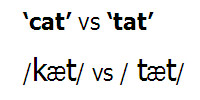
The first sound in these words are usually aspirated, but as English does not contrast aspirated vs unaspirated plosives (phonemically) the difference is not annotated in a phonemic transcription.
Phonetic Transcription
Phonetic transcription uses a larger set of symbols to capture more phonetic detail relating to the actual production of the utterance.
There are two types of phonetic transcription:
– broad phonetic transcription
– narrow phonetic transcription
Broad Phonetic Transcription
Broad phonetic transcription of speech does not attempt to record the extremely large number of idiosyncratic or contextual variations in pronunciation that occur in normal speech nor does it attempt to describe the individual variations that occur between speakers of a language or dialect.
The goal of a broad transcription is to record the phonemes that a speaker uses rather than the actual spoken variants of those phonemes that are produced when a speaker utters a word.
Strictly speaking:
a “broad phonetic” transcription classifies speech sounds into broad classes of actually spoken sounds
and
a “phonemic” transcription classifies speech sounds in terms of the phonemes that a speaker intends to communicate.
In practice, however, the terms “broad phonetic” and “phonemic” transcription are often used interchangeably and mean the transcription of phonemes.
Symbols for phonemic transcription
The most widely accepted system of symbols is the International Phonetic Alphabet (IPA).
This alphabet is used to represent both phonemes and allophones in normal practice even though it is defined in terms of actual speech sounds.
When linguists are developing a phonemic description of a language or dialect they most often select the most common or widely distributed allophone of each phoneme as the typical allophone of that phoneme and use its phonetic symbol to represent the phoneme as a whole.
When a symbol is used to represent an actual sound (allophone) it has an entirely different meaning to the same symbol when used to represent a phoneme. For this reason we always enclose transcriptions in /…/ when we are indicating phonemes and in […] when we are indicating the actually produced sounds.
Phonemes of English (pdf document)
Word Stress
Primary Stress
In English, the syllables of words differ in prominence.
In polysyllabic words (words of more than one syllable), one of the syllables always has a greater degree of prominence than any other syllable.
The syllable of greatest prominence is known as the primary stressed syllable, or the syllable that carries primary stress.
The primary stressed syllable can be marked by placing a diacritic in the following way:
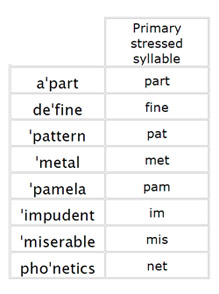
In monosyllabic words (words of one syllable), the outcome is unambiguous: the syllable, i.e. word, has primary stress (e.g. heat, look, greet) and does not need to be marked.
Secondary stress
Many words have two stresses, one primary and one secondary. The secondary stress can be marked by placing the diacritic before the syllable which has secondary stress:
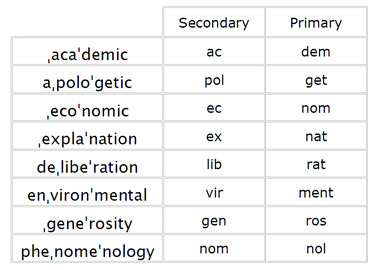
Further comments
i. words that have secondary stress are very often morphologically related to simpler forms
ii. secondary stress (mostly) precedes the primary stress
iii. at least one syllable (usually) intervenes between the secondary and primary stress
Exceptions to (ii) and (iii):
Compounds
A compound is a word which is composed of two separate words.
e.g.
roadblock
sunglasses
loudspeaker
These have two stresses, one of them primary, the other secondary.
The secondary stress can precede or follow the primary stress, and there need not be an intervening syllable:

Unreduced syllables
There are some words in which the secondary stress can follow the primary stress.
In such cases, it is conventional to refer to the secondary stressed syllable as an unreduced syllable.
The same diacritic can be used to indicate an unreduced syllable.
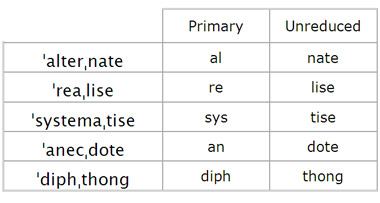
In some cases, the occurrence of an unreduced syllable is predictable (eg. words ending in -ate or -ise), in others it is not.
Unstressed syllables
In almost all cases, syllables other than primary stressed, secondary stressed or unreduced syllables are unstressed.
Generally in English, the large majority of the vowels of unstressed syllables can be transcribed as schwa:
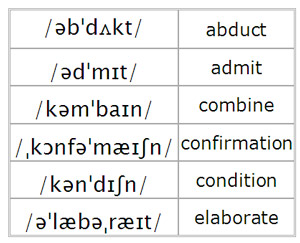
There are also some cases when unstressed vowels have a quality other than schwa
It is not possible to list them all, but some of these include words that end in unstressed -ish, -ic, -ism and -ing
e.g.


I came across your blog on technorati and check a few of of your early posts. Keep up the good work. I just added up your RSS feed to my MSN News Reader. Looking forward to reading more from you later on!
Thank you 🙂
its very good blog for learning the phonetics in a better way.
thanks u for this instructive blog
thanks a whole lot.you just saved a soul.
thank you very much!
I love it. You made it look simple and easy. Thanks, it helped me.
THANKS A LOT
thank you so much Azu, your really helped.
Thank you a lot for this great job. It’s really very important for language learners and teachers.